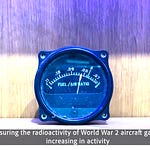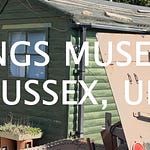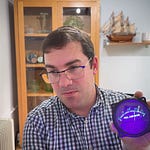Fact sheet…
Discovered: At an antique shop in Dorking, UK
Age: 1917
Radioactivity: 95.6 uSv/hr (roughly 780x background radiation)
Maker: Francis Barker & Son
History of the maker: The company was founded by Francis Barker in Clerkenwell, London, in 1848. They were a major supplier of military-grade compasses to Allied forces during World War I.
More about this item
At one point, this was the most radioactive item I owned. It was found ‘in the wild’ sitting on a busy shelf in an antique shop in Dorking, UK. It clearly emits intense gamma rays, meaning I sadly have to keep this compass away from every living thing.
The prismatic compass had a patented design that allowed for simultaneous sightings of an object and the reading of a bearing. It has a foldable heads-up display with a thin hairline used for a target, with the compass viewable at the same time for the bearing. My particular WW1 prismatic compass is unusual as it is liquid-filled - a more premium and modern version that enabled faster movement - but apparently these were not standard issue.
What makes this compass so radioactive is the large amount of radium used mixed with zinc sulfide to make it glow - a crucial feature for nighttime operations. Sadly, only one part of my compass now glows, as the large amount of radium used has burnt out the zinc sulfide (a common occurrence). Based on my compass’s readings, I can only imagine that every inch of this beautiful device once glowed - potentially even in the murky kerosene liquid, given its brown radium colour.
Of course, I’m enjoying this item, so you don’t have to. More videos to come.






